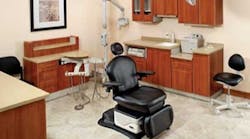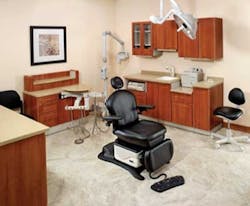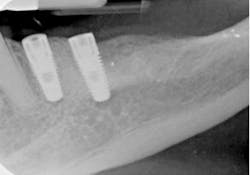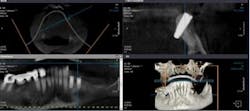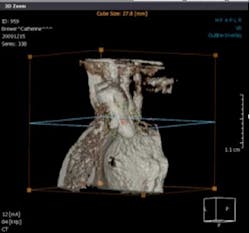Cone beam imaging is radically transforming dentistry
Images of coronal, axial, and sagittal planes, as well as enhanced VR imageIn 2008, I incorporated the Planmeca ProMax 3D into our office. My practice, Huntington Bay Dental, is a general dental practice that provides a full range of restorative and surgical services to patients of all ages. Along with my partner and associate dentists, we routinely place as well as restore dental implants.Our decision to introduce cone beam technology was initially based on the knowledge that the state-of-the-art in implant treatment planning involved the use of three-dimensional imaging; however, our patients were forced to go to outside facilities for this service. CAT scans at imaging centers provided us with a great deal of information, but at a greater cost to the patient in terms of both higher radiation and more dollars.We selected the Planmeca ProMax 3D because of its smaller footprint size, its accuracy, and its ability to take both a two-dimensional panorex as well as a three-dimensional cone beam image. As an instrument for treatment planning implant cases, it exceeded all of our expectations, with the added bonus being that we were able to take more cases from diagnosis to completion — patients not only saved money, but they also did not get “lost” in the referral process for imaging. To our surprise, however, we found that 3-D imaging became indispensible in a wide range of dental diagnosis and treatment planning, to the point that there are many cases today where we cannot even imagine understanding how to best help a patient without the use of the third dimension. We found applications in endodontics with visualizing fractured roots, periapical pathology, and accessory canals; in treatment planning for the extraction of third molars in proximity to the mandibular nerve; in diagnosing pathology of all types; in understanding the cause of previously undiagnosed pain; in visualizing sinus pathology; in understanding the etiology of temporomandibular joint dysfunctions; and in diagnosing the true extent of periodontal pathology and disease in localized areas. And while we do not practice orthodontics, we are well aware of the orthodontic applications of 3-D imaging.In implant treatment planning, we have come to hold the strong opinion that the standard of care today in implant dentistry is to recommend 3-D imaging for implants for nearly every patient, and because of this it would be poor practice to do implants without using 3-D imaging. This philosophy has quickly expanded into all phases of our practice of dentistry. I am by no means implying that 3-D images are required for all patients, but rather am stating that I strongly believe that there are cases where two dimensions are simply not enough, and the addition of the third dimension — when applicable — becomes the only means of providing an accurate diagnosis. The presence of this technology has forever altered the standard of care in our profession with respect to diagnosis and treatment planning. 3-D cone beam imaging has raised the bar and redefined the standard of care for many areas of dental practice. The World War I song from 1919 by Byron G. Harlan with Ada Jones titled “How Ya Gonna Keep 'Em Down On the Farm After They've Seen Paree” just about sums up my view regarding the presence of cone beam imaging in dentistry. The technology is here in an affordable and ergonomic form, providing diagnostic capabilities far beyond what is available with 2-D. When indicated, there simply is no sound excuse for not incorporating the technology. And the words written by Bill Gates in 1999 ring true: “How you gather, manage and use information will determine whether you win or lose.”For dentistry, “winning and losing” is not primarily a financial consideration. Winning and losing ultimately deals with the quality of care that we provide our patients, and doing all within our means to assure the best outcome for every procedure we perform. The third dimension in dentistry raises the odds for consistent success.Does visualization of the third dimension really make a difference?
Eugene Antenucci, DDS, is a general dentist who maintains a full-time private practice in Huntington, N.Y. His state-of-the-art dental facility is also home to a continuing dental education training center for dentists, as well a commercial dental laboratory. His practice, Huntington Bay Dental, was distinguished as “Dental Practice of the Month” by Dental Economics in May 2003 and “Business of the Year” by the Huntington Chamber of Commerce for 2003. Dr. Antenucci is a 1983 graduate of New York University College of Dentistry. He was awarded his Fellowship in the Academy of General Dentistry in 1992, the American College of Dentists in 1999, and the International College of Dentists in 2005. Dr. Antenucci is a certified CEREC Basic and Advanced Training Instructor, and has conducted training seminars throughout the United States. He lectures internationally, conducting seminars in the clinical utilization of advanced technology in dentistry, as well as seminars in cosmetic dentistry, practice management, CEREC, and laser training. Dr. Antenucci serves on the Board of Benefactors of the Guide Dog Foundation and America’s Vet Dogs, and is also an active member of the National Italian American Foundation, serving as the New York Area Coordinator for the organization. Dental equipment manufacturer Planmeca USA has retained Dr. Antenucci as a spokesperson for its line of 3-D imaging products and to advise the company on marketing, advertising, and continuing-education efforts.
